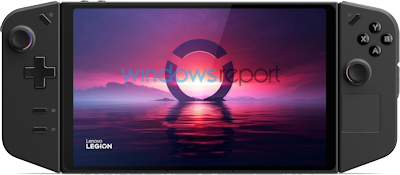Specifications, Release Date, and Pricing Leaked for Lenovo Legion Go
AMD may now have an even stronger incentive to enable FSR3 for integrated GPUs…

The competition in the handheld gaming device arena is intensifying. The upcoming release of the Legion Go promises to be a formidable counterpart to the Ryzen Z1-based Ally. On paper, the device boasts faster memory, a larger screen with higher resolution and refresh rates, increased battery capacity, all at the same price point (in Europe). However, whether this will be sufficient for ASUS to reduce the price of the Ally remains uncertain.
New information from Windows Report, apparently sourced from press materials about the forthcoming device, reveals that the Legion Go is set to hit the market next month. But the company is poised to announce it this week on September 1st, most likely coinciding with IFA 2023, which also commences on the same day.
The Legion Go is now confirmed to feature the Ryzen Z1 Extreme from AMD. This means the Go will be equipped with the most powerful AMD Phoenix APU designed for gaming consoles, sporting 8 Zen4 cores and 12 RDNA3 compute units. Additionally, it will support a lower TDP compared to consumer Phoenix APUs for laptops.
Lenovo Legion Go, Source: Windows Report
Significantly, the Legion Go will come with faster memory on board, surpassing that of the ROG Ally. Instead of the 16GB LPDDR5-6400, the Go will feature LPDDR5X-7500. Given that gaming performance often hinges on system memory in devices lacking discrete graphics, this upgrade is expected to impact overall performance positively.
This enhanced performance may be crucial for rendering frames on the 8.8-inch screen, boasting a resolution of 2560×1600 and a 144Hz refresh rate. This resolution exceeds that of the ROG Ally (1920×1080 at 120 Hz). The screen is reportedly an IPS display with 97% DCI-P3 color gamut coverage and a peak brightness of 500 nits, making it comparable to the Ally.
Lenovo Legion Go, Source: Windows Report
To accommodate the power demands of the larger screen, the Legion Go will house a 49.2 WH battery, surpassing both the Ally and Deck (40 Whr). Remarkably, the device’s weight will not increase significantly compared to the Ally, adding only 32 grams, but only when the controllers are not attached. It’s worth noting that the Legion Go will introduce Nintendo Switch joy-con-like controllers that can be detached for remote play. However, when using these controllers, the device’s weight will reach 854 grams.
Regarding pricing, the device is expected to be unveiled on September 1st, with a price tag of €799 in the EU and $799 in the US. It’s worth mentioning that the console will be launched a month later. In terms of pricing, it will match the ROG Ally in the EU but come with a $100 price increase in the US.
Additionally, gamers will have the option to purchase Legion Glasses for $499/€499 and Legion E510 7.1 RGB Gaming In-Ear headphones for an extra €49. All things considered, Lenovo is clearly aiming to compete with the Ally by offering similar pricing, improved specifications, and additional features. However, some gamers may still prefer the lighter Ally without removable controllers.
| Handheld Gaming Consoles | |||
|---|---|---|---|
| VideoCardz | Lenovo Legion Go | ASUS ROG Ally | Valve Steam Deck |
| Picture |  |  |  |
| Architecture | AMD Zen4 & RDNA3 | AMD Zen4 & RDNA3 | AMD Zen2 & RDNA2 |
| APU | Ryzen Z1 Extreme 8C/16T up to 5.1 GHz | Ryzen Z1 Extreme [1] 8C/16T up to 5.1 GHz Ryzen Z1 [2] 6C/12T up to 4.9 GHz | AMD Van Gogh 4C/8T up to 3.5 GHz |
| SoC GPU | AMD iGPU 12CU @ 2.7 GHz | AMD iGPU 12CU @ 2.7 GHz [1] 4CU @ 2.5 GHz [2] | AMD iGPU 8CU @ 1.6 GHz |
| SoC TDP | 9-30W | 9-30W | 4-15W |
| External GPU | TBC | ROG XG Mobile (up to RTX 4090) | Not officially |
| Memory Capacity | 16GB LPDDR5X-7500 | 16GB LPDDR5-6400 | 16GB LPDDR5-5500 |
| Storage Capacity | 1TB/512GB/256GB | 512GB[1]/256GB[2] | 256GB/512GB SSD 64GB eMMC |
| Storage Type | M.2 NVMe 2242 SSD PCIe 4×4 | M.2 NVMe 2230 SSD PCIe 4×4 | M.2 NVMe 2230 SSD PCIe 3×4 eMMC PCIe Gen2x1 |
| Display | 8.8″ 2560×1600 IPS, 144Hz (VRR), 500 nits | 7″ 1920×1080, 120Hz (VRR), 500 nits, 7ms | 7″ 1280×800, 60Hz |
| Connectivity | TBC | Wi-Fi AX, BT 5.2 | Wi-Fi AC, BT 5 |
| Battery | 49.2 Whr, 900 mAh (controllers) | 40 Whr, 4S1P, 4-cell Li-ion | 40 Whr |
| Weight | 854g (with controllers) | 608g | 669g |
| Dimensions (LxWxH) | 29.9 x 13.1 x 4.1 cm | 28.0 x 11.3 x 3.9 cm | 29.8 x 11.7 x 4.9 cm |
| OS | Windows 11 | Windows 11 | Steam OS/Win 11 |
| Retail Price | $799/€799 (Z1E+?6G+?GB) | $699/€799 (Z1E+16G+512GB) $599/€699 (Z1+16G+256GB) | $649/€679 (16G+512GB) $529/€549 (16G+256GB) $399/€419 (16G+64GB) |
| Release Date | October, 2023 | June 13th, 2023 [1] Q3 2023 [2] | February 2022 |
Source: Windows Report




